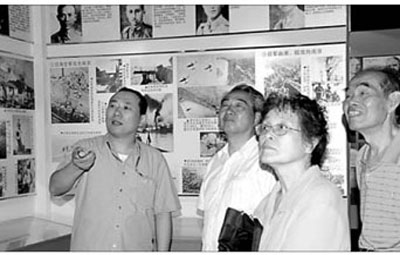In the city trampled by the invading Japanese troops 70 years
ago, people have different ways of dealing with their grief and
anger.
And the method adopted by the 42-year-old owner of a
manufacturing factory, Wu Xianbin, is quite unique.
Wu, owner of a Nanjing-based manufacturing factory, started a
private museum to house historical documents about the War of
Resistance against Japanese Aggression (1937-45), which anyone can
visit free of charge.
The two-storey hall covers 1,000 sq m and occupies the northeast
side of Wu's factory. The exhibition space comprises four rooms
displaying hundreds of pieces of weaponry used by the Japanese
troops in Nanjing, 3,000 books on the war in various languages and
30,000 photographs.
"It took me five years and 5 million yuan ($625,000) to collect
all of those materials related to the war," says Wu. "I have spent
a long time finding and convincing former Japanese army journalists
to sell me the photos they took during the war."
Wu, initially a book collector, bought an English book on the
1937 Nanjing Massacre by chance in 2002, which turned out to be of
high historical value.
This inspired the entrepreneur to collect more.
Wu Xianbin (left) acts as a
narrator for visitors to his private museum about the War of
Resistance against Japanese Aggression. (file photo from China
Daily)
"It is such a tragedy but how many people now actually remember
Nanjing Massacre?" Wu asked. "It is far less famous as the atomic
bomb on Hiroshima and the Auschwitz Death Camp."
Wu began investigating the war and decided to set up a museum so
that people could remember and learn more about the tragedy and the
war itself.
Over the years, the factory owner and middle school graduate has
become quite the history buff, and he regularly acts as a narrator
for visitors.
"Different from the materials presented in the official memorial
hall for the massacre, which emphasizes the tragic slaughter of
Nanjing people, my collection also stresses the efforts made by the
Nanjing residents in striking back against the Japanese," Wu
says.
Such was Wu's commitment to the museum that his family began to
raise concerns that he was neglecting his other pursuits.
"He hardly made any money, but lives on the rents of houses from
other enterprises," says Wu's wife.
Wu says that he rarely seeks publicity for the museum, apart
from occasional TV interviews.
"The best support the government gives me is to allow me to hold
the exhibition," says Wu.
"The museum, though not so big, has taught me many things. And I
began to realize what happened to our city during the 1930s," says
Wu Jian, a local resident who visited the museum.
Wu also hopes that academics from both China and overseas will
take advantage of the resources he has amassed.
"I want them to join the research and demonstrate their findings
to the world in an unbiased way," he says.
Wu says that many recent films about the Nanjing Massacre have
used the collection as a reference.
But he didn't do it all on his own. Wu says that he did get some
help from both Chinese and Japanese experts. These experts have
become regular visitors of the museum, he says.
(China Daily December 17, 2007)


